As readers of Jane Austen—and novels in general—we are accustomed to the idea of the single creator. The same applies to poetry. Drama is a little more complicated because the process involved in translating a script into a performance involves a greater number of participants. Film is clearly closer to drama than to the novel or poetry. We only need to linger and read the lengthy list of credits at the end of a movie to realize this. Not all these credits are crucial to the creative aspects of a film. The caterers might have a significant impact on an actor’s after-lunch performance, but their identity is not something with which students of the genre are likely to be concerned. Many others, however, have an important role to play in the success of a movie production. Whether there is a first among the many is a matter of some debate.
According to French New Wave theorists of the late 1950s and early 1960s, including François Truffaut and Jean-Luc Godard, to be successful, a film, as a primarily visual medium, requires a director who is effectively its author or auteur. In their view, even films cranked out by the production line of the Hollywood studio system could be artistically successful when made by directors, such as John Ford, Alfred Hitchcock, or Howard Hawkes, capable of stamping them with their own personalities. The only person afforded a status close to the director by the New Wave theorists is the editor, with whom the director frequently collaborates closely in cutting the final version of the film. Notable examples of such partnerships are Ingmar Bergman and Sylvia Ingemarsson, Martin Scorsese and Thelma Schoonmaker, and Mike Leigh and Jon Gregory. As Godard says, “to speak of directing is automatically to speak, yet and again, of editing” (Orpen, 4).
Something equivalent to auteur theory has also played a significant role in the assessment of television films and series. In this case, though, as might be expected of a medium that has been far less visually sophisticated than film until recent years, it is the bodies of work produced by certain writers that have most often won critical acclaim. Among the most famous in British television are Alan Bleasdale, Dennis Potter, and, best known to fans of costume dramas, Andrew Davies.
Since Andrew Davies wrote the script for Sense & Sensibility (2007), most viewers would have little problem with describing him as the auteur. After all, his is the only name that appears on the front of the DVD box. Furthermore, Anne Pivcevic has asserted that Davies is the “King” of adaptations and that “the script is 90% of the success of a production” (Pivcevic and Davies). Nevertheless, while acknowledging the crucial part Davies played in the making of the 2007 adaptation of Austen’s novel, I hope to demonstrate that his was only one of a number of important contributions. This is a position with which Pivcevic would ultimately agree: “It’s very, very collaborative in the end” (Personal Interview). In addition to what I have been able to deduce from close examination of the film, I have relied on three main sources for my understanding of the complex process that went into the making of Sense & Sensibility: my interviews with Andrew Davies and Anne Pivcevic, the film’s producer; Davies’s unpublished script; and the interviews and commentary track included with the DVD of the film.
Chronological sequence: producer and scriptwriter
I begin my analysis with an overview of the chronological sequence during which a group of people with the necessary creative and technical filmmaking skills were drawn into a process that engaged them individually and collaboratively. First, as Anne Pivcevic explained in my interview with her, the BBC’s drama commissioner decided it was time for a new adaptation of Austen’s novel. Ten years had passed since the Emma Thompson/Ang Lee film and over twenty years since the last television version, written by Alexander Baron and directed by Rodney Bennet in 1981. Pivcevic was then appointed to produce the film, a role that for the BBC involves not only logistical responsibilities but considerable creative input. She, in her turn, hired Andrew Davies as scriptwriter. Before beginning on his screenplay, Davies met with Pivcevic to establish some guiding principles in what was, according to Davies, an unusually “long lead-up time” (Personal Interview) that allowed for a thorough analysis of how the film should be shaped. The four main principles were as follows: to cast actors of a suitable age for the parts of the young lovers; to develop the characters of Edward Ferrars and Colonel Brandon; to remove ambiguity from Willoughby; and to employ cinematic methods in developing potentially abstract themes of money and social position.
The influence of these guiding principles is evident throughout the script that Davies then went away and wrote. Davies and Pivcevic were determined that the major roles in their film would be played by actors of similar age to Austen’s characters—“one of the most important things for us was to make the cast young . . . , to give it fresh energy” (Pivcevic and Davies)—thereby distinguishing it from the earlier Thompson/Lee version of Sense and Sensibility.1 To this end, Davies invented several scenes only suitable for youthful protagonists.2 His Elinor Dashwood, in a display of her frustration with Fanny Dashwood, beats carpets and later roams the countryside and cliffs in typically lovelorn teenager fashion; his Edward Ferrars rides recklessly and seeks his form of emotional release through violent wood chopping.3
Invented scenes serve more generally to help flesh out and add plausibility to Edward Ferrars and Colonel Brandon, characters who, in Davies and Pivcevic’s view, were inadequately realized by Austen: “She needed to do more with both of them” (Davies, Personal Interview). Davies even went so far in his interview with me as to say that “Austen needed another draft at least.” Besides the scenes above, Davies sought additional complexity by creating a scene in which the “man of action” Brandon reveals his tender side during a visit to the abandoned Eliza and her baby, and a chicken chasing scene that serves to demonstrate the once depressed Edward’s capacity for playfulness.
Anne Pivcevic has described the problem of Willoughby’s ambiguous role in the novel thus: “There is a lot of ambiguity in the novel. . . . Willoughby is also seduced by Marianne. . . . He did experience true and deep emotion [but in the end] chose money” (Personal Interview). To remove much of the ambiguity from Willoughby, Davies starts his script with a scene in which Willoughby seduces and abandons the fifteen-year-old Eliza. The way is thus prepared for a darker understanding of the overtly romantic Allenham scene and a re-writing of Willoughby’s conversation with Elinor at Cleveland so that it concludes with her displaying none of the sympathy she experiences in the novel. It should be noted, however, that, to avoid making Willoughby too one-dimensional, Davies dramatizes the visit to Allenham in such a way that he reveals real feelings for Marianne and passes up an opportunity for an easy seduction.
Finally, Davies and Pivcevic agreed that the film would be more cinematic if, in addition to discussions of finances, the interior and exterior characteristics of houses and their settings were employed to point up the Dashwood women’s social decline. The move to a small and remote cottage “is a good way of emphasizing the isolation of the girls,” Pivcevic said. “Once they have lost their ancestral home, they have no place in society” (Pivcevic and Davies).
More generally, Davies’s script demonstrates qualities familiar to viewers of his earlier adaptations of classic novels. These include an ability to condense a lengthy text into a script of the required length without losing plot clarity or too much character or thematic complexity; the creation of a stylish pastiche out of a melding of his own slightly simplified and modernized dialogue and the author’s original words; the subtle introduction of a modern perspective into a screenplay that in general stays close to its source—in this case by contrasting the current subjugation of women in a patriarchal society and the possibility of a different future as represented by Margaret Dashwood’s feminist attributes; the development of humorous elements even beyond those present in Austen’s novel, most notably in his portrayals of little Henry, the John Dashwoods’ son, and Margaret, characters who barely appear in the novel; and, less subtly, the sexing up of the original work particularly in the seduction scene with which the film opens and the erotic interplay between Willoughby and Marianne displayed during the episode in which he cuts a lock of her hair and their clandestine visit to Allenham.
Chronological sequence: the creative team
Once the first draft had been completed, it was time for the creative team to meet and talk about how the bare bones of Davies’s script might be fleshed out into the multi-layered audio-visual medium of film: “We started the whole process with everyone sitting around the table. . . . Costume designer, designer, hair and makeup. We sat around and talked about the kind of film we wanted to make. Everybody is part of the vision, and everybody interpreted it in their own discipline. . . . All very organic” (Pivcevic). John Alexander, the director, was the team’s most important member, and from this point on “he had an input into the script” and worked “in a real marriage” with Andrew Davies (Pivcevic). However, given that Alexander “came on board when we had the script” (Pivcevic) and did not participate from the beginning, he clearly does not qualify for auteur status. James Merifield was next in order of precedence. As the Production Designer, he was responsible for the overall “look” of the film. Paul Girardini, the art director, worked under Merrifield, and below him were costume and hair/make-up designers, Michele Clapton and Karen Hartley-Thomas. The team was completed by the casting director, Kate Rhodes James, and location manager, Rupert Bray.
Most of the team then started to prepare for filming. The casting director sent the script, considered crucial in attracting the best actors, out to potential cast members. Auditions followed, which were attended by Pivcevic and Rhodes James. They were looking for actors with the ability to embody their characters’ personalities rather than merely possessing a close physical resemblance to the novel’s originals. Hence, Hattie Morahan was chosen because she exemplifies Elinor’s “calmness and depth,” and Charity Wakefield stood out because she possessed Marianne’s “vulnerable indignation” (Pivcevic). Based on their contributions to the DVD’s commentary track, the actors did not have any significant creative input into the shaping of the script or their roles. Therefore, successful as they were in realizing the writer and director’s intentions, I will not be paying them much attention in the later parts of this paper.
Once the cast was in place, the costume and hair/make up designers could start their work. Costumes and hair were designed as much to reflect aspects of the characters’ personalities as for period authenticity. For example, until late in the film, the extrovert Marianne’s clothes are usually brighter and more stylish than those of her more restrained sister, Elinor.
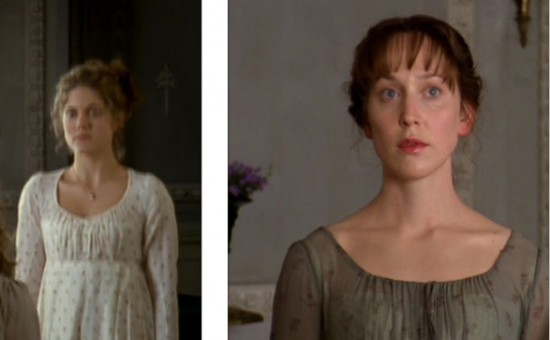
Similarly, the Steele sisters, for whom social performance is a priority, have much more coiffured hair than the Dashwood sisters, who place personal integrity over mere display. This difference is demonstrated by the close-up shots above and below.
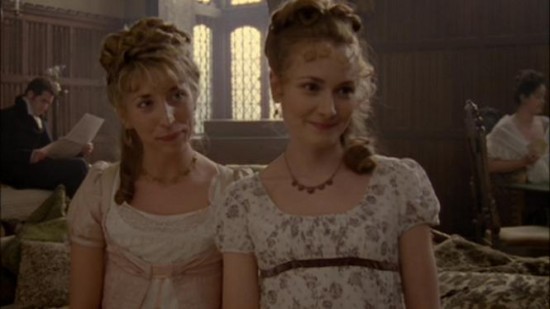
Such attention to detail is one of the many factors that distinguish the 2007 Sense & Sensibility from earlier BBC adaptations. In the 1971 version, for example, Elinor and Marianne have very similar hair styles, costumes, and even resemble each other physically. As a result, an opportunity to reflect character difference visually was lost.
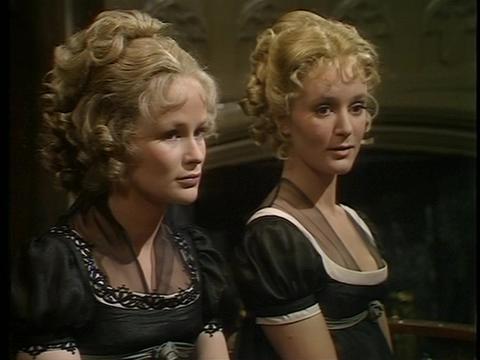
For their part, the location scout and production designer, along with the director, sought out locations, both exterior and interior, that were at once appropriate to the film’s thematic goals and that would be visually appealing to the audience. Final approval lay with Pivcevic and Alexander working from photographs (Pivcevic, Personal Interview). They were particularly pleased to be able to choose a remote cottage in Devon whose proximity to the sea would prove to be invaluable in helping John Alexander add a romantic dimension to the film. The contrast with Norland Park is visually striking and illustrative of the drastic change in the Dashwood women’s social status, thus achieving one of Pivcevic and Davies’s primary goals for the film.
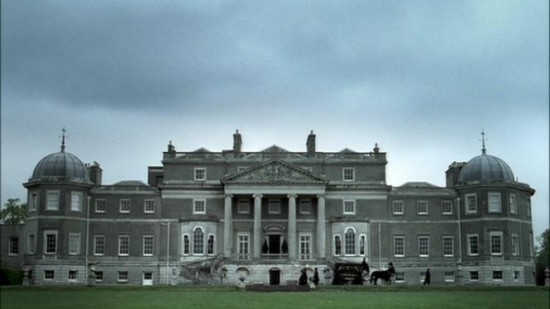

Given places to work in and around, Merifield, whom Pivcevic described as “very story oriented” and who “read the script in great detail” (Personal Interview), and Girardini could then begin to focus on more detailed aspects of the film’s design. For example, Merifield, inspired by a period painting of a girl with goldfish, was responsible for the bowl with its two goldfish, a memento of Margaret’s life at Norland. The girl’s sense of the loss of her previous home is reflected in the attention she pays to the bowl both on the journey by carriage to Devon, when she carries it on her knee, and at her new home in Barton Cottage.
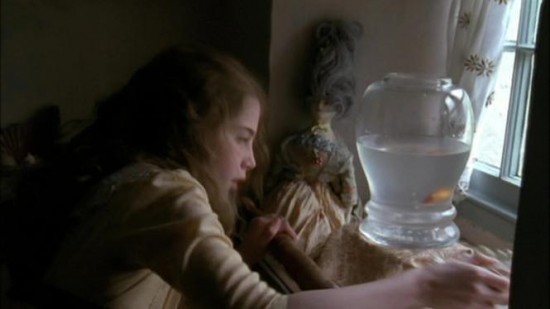
Whereas the goldfish bowl was undoubtedly a found object, Merifield and his team created the letters, the family Bible, and the inscribed pencil case that Elinor finds in her father’s desk. Because the last two objects in particularly bear such personal markers of her father’s identity, they provide a clear route to understanding the deep grief that lies beneath the calm surface that Elinor maintains as she contemplates them.
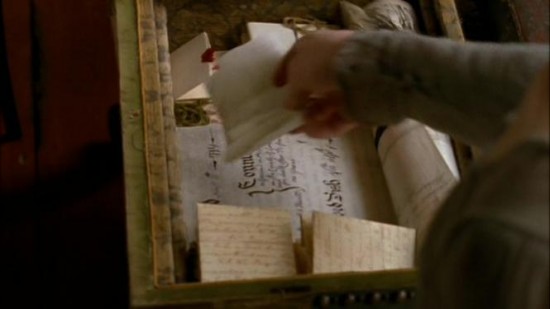

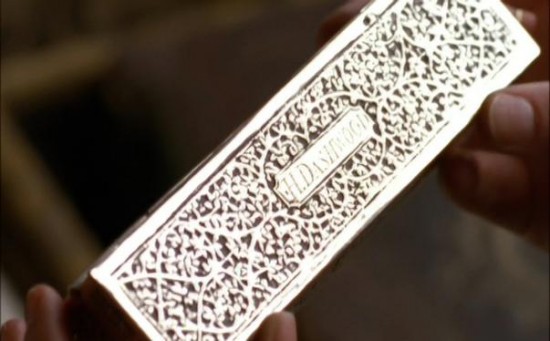
Chronological sequence: shooting: director and cinematographer
Finally, filming could begin. The primary roles were now those of the director, John Alexander, the cinematographer, Sean Bobbit, the actors who came and went as their roles demanded, and Anne Pivcevic, who was on set for most of the filming and dealt with artistic and practical issues.
It was Alexander’s job to decide how Davies’s script should be shot. Davies—who commented to me in our interview that “I can see it in my head. . . . I’m kind of directing as I write it”—provided Alexander with plenty of guidance. Perhaps the most notable instance where Alexander took his lead from the script is the Allenham scene:
© 2007 BBC
For this scene Davies, in pursuit of a deeply erotic atmosphere, proposes a “dark” room, “because so many windows are shuttered. Shafts of light through chinks.” Then, “Willoughby picks up a delicate shawl, and throws it around her shoulders.” After that, “[h]and in hand, Willoughby leads Marianne up the fine staircase.” Finally, “they are very close—her face upturned. They kiss. On the mouth, but it’s a first time, light and tentative.”

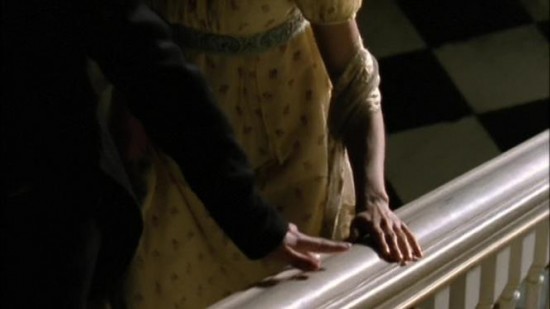 In the final cut it is Marianne who throws the shawl over her own shoulders and the hands never quite meet, but apart from this, the scene conforms closely to the scenario laid out by Davies.
In the final cut it is Marianne who throws the shawl over her own shoulders and the hands never quite meet, but apart from this, the scene conforms closely to the scenario laid out by Davies.
At other times, Alexander went his own way, just as Davies expected he would: “I’m trying to control the director, trying to make him see what I see, [but] I am very happy if he sees something different” (Personal Interview). Most notably, Alexander added several scenes that do not appear in the script, such as the episode in which Elinor walks on the cliffs and stares out at the sea while thinking about Edward, and the one in which she stands alone in a dark cave, a scene improvised when bad weather interrupted the planned shooting schedule.
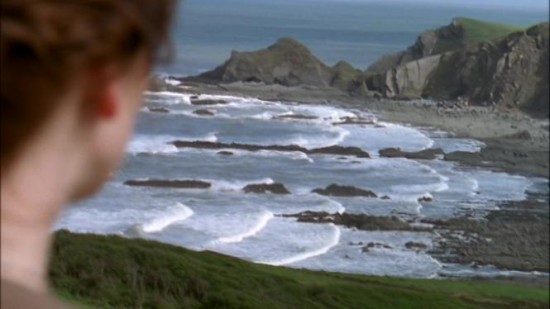
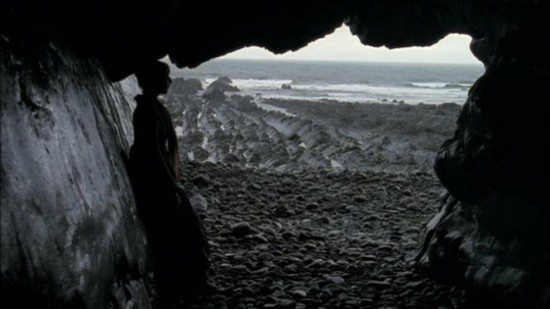
He also introduced many shots of the pounding ocean.
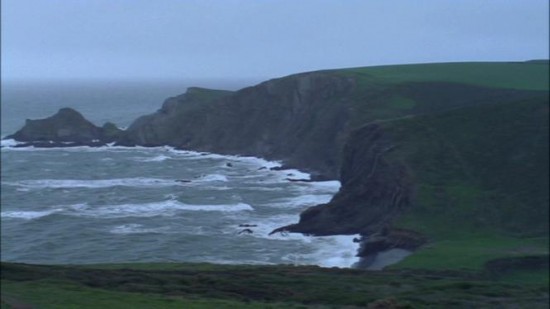

The point of such scenes is, as Alexander put it himself, to “bring the Bronte out” (DVD Commentary Track) in Austen, thus making the film more romantic than Davies intended. In his script, Davies follows Austen closely in favoring Elinor’s sense, which includes an ability to control her feelings rather than burden others with them, over Marianne’s sensibility with its mix of genuine feelings and self-indulgence. Thus, he has Elinor gently debunk Marianne’s rapturous repetition of the name “Willoughby of Allenham”: “Willoughby of Allenham has left some muddy footprints in the passage.” When Marianne refuses to follow social norms, Elinor offers a more serious rebuke: “Don’t you think it was ill-judged of you to go [to Allenham], with no one else but Mr. Willoughby?” Some painfully disillusioning experiences finally teach Marianne that her behavior has been excessive and selfish, and that she should have been guided by Elinor: “I was a fool to myself and inconsiderate to everybody else. . . . I compare my [conduct, not with Willoughby’s] but with what I should have been—I compare it with yours. I hope I am wiser now.”
Given Davies’s fidelity to Austen’s critical stance towards the cult of sensibility, it is not surprising that his description of the Dashwoods’ new home is much closer to Austen’s than to the one chosen for the film. Thus, we can note a marked resemblance between the placidity and gentleness of Davies’s cottage—“pretty, nestling into the hill . . . , with fine views across moorland” (Davies, Script)—and Austen’s Barton Valley, which is “a pleasant fertile spot, well wooded, and rich in pasture. . . . As a house, Barton Cottage, though small, was comfortable and compact” (SS 28).
In a further deviation from the original script, Alexander occasionally asked Davies to write new dialogue. Edward’s proposal to Elinor is a notable example. In the original script, Edward proposes rather abruptly, whereas in the rewritten version he offers a lengthy account of his past conduct and of his feelings for Elinor before speaking Davies’s original lines: “Miss Dashwood—Elinor—can you forgive me—can you love me? Will you marry me?”
In the comments he makes on the DVD commentary track, Alexander barely mentions the role of Sean Bobbit, the film’s cinematographer. We therefore can have no clear idea of his contribution to creating the mise en scène or the shot selection. It is likely to have been significant as Bobbit is an experienced professional with later credits in cinema and film, including Shame and Hunger, both directed by Steve McQueen, and was nominated for an Emmy for his work on Sense & Sensibility. Bobbit himself has spoken of seeing the cinematographer’s role as one in which he realizes the director’s ideas and objectives and works in collaboration with the rest of the creative team. He would, therefore, seem to have been a great resource for Alexander and to have had a significant role in creating the fluid and very cinematic style of the film—achieved through a combination of tracking, cutting, and changes of distance and angle—that is in marked contrast to the more ponderous or theatrical style of older television drama productions and the graceful and leisurely style of the Thompson/Lee film. Tour de force shots such as the bird’s eye view of the Steele sisters in the hall at Mrs. Jennings’s London house and the remarkable extreme close-up shot of Elinor and the doctor reflected in Marianne’s eyeball are much more likely to have originated in Bobbit’s imagination than Alexander’s.
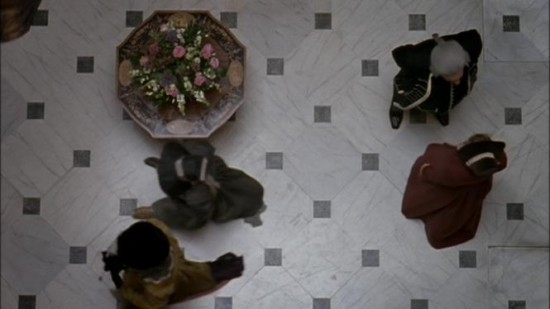
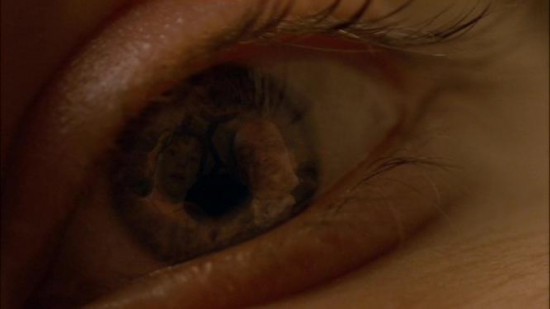
The next stage after filming is editing, and Alexander has spoken enthusiastically about his relationship with the film’s editor, Roy Sharman, an experienced professional who has worked in television since 1980. The editing process is one in which, as Alexander describes it on the DVD commentary track, the film’s action is “compressed, condensed . . . , clarified,” and given “more energy.” For example, an entire scene, closely based on dialogue from Austen’s novel (SS 282–83), in which Brandon informs Elinor of his intention to provide the disinherited Edward Ferrars with a clerical living, was cut to sharpen the action and shorten the film. The director and editor judged a later conversation in which Elinor passes on a message that seems to open up the way for Edward to marry Lucy to be more than sufficient in that it not only communicates the essential information but shows Elinor gripped by a struggle between social obligations and personal feelings: “I—have some good news for you—at least I hope you will think it is good news. [pauses] Colonel Brandon wants to offer you the living at Delaford.”
Chronological sequence: post-production: editor and composer
Alexander gives particular credit to Sharman for his work on the Allenham scene, the romantic and erotic atmosphere of which owes a great deal to the lyrical montage of mostly close-up images through which it is developed (as illustrated by the earlier clip and screen captures). The London ball also demonstrates Sharman’s editing skills. One purpose of the editing is to communicate the energy of a crowded ballroom. Another is to extract the full potential from raw footage shot primarily in close-up and intended to place emphasis on interactions between the major characters, in this case in the form of exchanged glances, rather than on the dancing and moving crowds that swirl around them. This scene thus functions in a way very similar to ballroom scenes in Austen’s novels.
© 2007 BBC
The action progresses from a high-angle overview of the lively dancing to a sequence, shot at eye level in close-up, that follows the varied preoccupations of Marianne, Colonel Brandon, Elinor, and Lucy Steele, and concludes with the disastrous encounter between Marianne and Willoughby.
Editing completed, the celebrated composer Martin Phipps, working with Anne Pivcevic and John Alexander, was brought in to create the film’s score. The music for Sense & Sensibility is mostly soaring and romantic in keeping with the emphasis introduced into the film by John Alexander.
Elinor alone in the cave.
(Click here to listen.)
As is typical of his compositional style, however, Phipps also made use of synthesizers, computers, and electric instruments to create music that represents the emotional journey of the characters, even if it is at the expense of period authenticity. As much as lighting, costuming, camera work, and editing contribute to its emotional impact, the Allenham scene would be less striking without Phipps’s haunting music, beginning with a hint of a distorted and hence disturbing “Twinkle, Twinkle, Little Star” that calls to mind demonic or evil children in literature and film,4 and is then comprised of tinkly and quite ethereal electronic sounds with the addition of a soaring violin as the two lovers kiss. The overall effect is to take the audience into Marianne’s head, where we experience her combination of naivety, romantic expectation (“it reminds me of Sleeping Beauty’s Palace”), sexual longing, fear, and anticipation.
Willoughby and Marianne at Allenham.
(Click here to listen.)
Another striking example of the compositional risks that Phipps will take to build the appropriate atmosphere is provided by the ominous repeated guitar notes and ambient sounds such as Brandon’s cries, and the horse’s whinnying and hoof beats that recur during his frantic ride in search of Marianne lost in the storm at Cleveland. After the danger is over and Brandon has taken Marianne up into his arms, the film’s main romantic score returns.
Brandon looking for Marianne.
(Click here to listen.)
Phipps’s music, then, with its mixture of the romantic, the disturbing, the erotic, and the dangerous not only complements but enhances the contributions of Sense & Sensibility’s other creators.
My focus up to this point has been on the chronology of the making of Sense & Sensibility and, as much as possible, on the separate contributions of the major figures involved in its creation: producer, writer, director, production team, casting director, location manager, cinematographer, editor, and composer. Now it is time to demonstrate what can be achieved when the individual skills of a group of talented individuals are subsumed within a collaborative enterprise. To this end, I will be examining the two episodes with which the film begins.
Two episodes: Seduction and Betrayal
The opening scene of Sense & Sensibility is one in which a “girl” is seduced and then abandoned by a mostly unseen “young man.” In writing this scene, Andrew Davies made several bold decisions: to dramatize an incident—Willoughby’s seduction of Colonel Brandon’s ward, Eliza—that is only described, retrospectively and at second hand, by Brandon in the novel; to move the scene from a position much later in the novel to the beginning of the film; and to withhold the information needed to identify the lovers. As a result, Davies provides the film with a shocking, puzzling, and emotionally powerful opening that sharply contrasts the leisurely summary of the Dashwood family history with which Austen begins her narrative.
By placing the seduction scene immediately before the novel’s first major episode—one that traces the stages in John Dashwood’s abrogation of his duty to honor his father’s deathbed wish that he “do something” for his wife and daughters—Davies links and makes central to his script the sexual and financial betrayal themes that are also Austen’s major thematic preoccupations. Davies makes his thematic point explicit by creating close linguistic links between the male seducer’s false assurance that his mistress can “trust” him and John Dashwood’s clearly expressed “I promise” to his father. The theme introduced here is to reappear later in the film in such episodes as Willoughby’s rejection of Marianne Dashwood in favor of a wealthier woman and Lucy Steele’s similarly motivated shift of affections from the disinherited Edward Ferrars to the new heir, his brother, Robert.
Although the identity of the lovers is not revealed until later in the script, and hence closer in time to when the reader learns of the episode in the novel, the opening scene ultimately serves two crucial purposes. First, as indicated earlier, knowledge of Willoughby’s treatment of another young girl adds an air of erotic danger to the Allenham scene. Second, it plays a significant role in fulfilling Davies and Pivcevic’s intention to make Willoughby the unambiguous villain of the piece. Retrospective though it may be, Brandon’s account of Willoughby’s callous treatment of Eliza has a powerful effect on Elinor in the novel. However, it cannot hope to match the intensity of a first-hand dramatization of the plausible and practiced way in which Willoughby takes advantage of an inexperienced girl before abandoning her the very next morning.
Several of the film’s creators played major roles in the filming of Davies’s script. These include the director, cinematographer, editor, and composer. Their main focus, as the scene develops, is a shift in atmosphere from the romantic to the seductive and then onto the disillusionment of the morning after. The lighting crew, working with the cinematographer, Sean Bobbit, and under instructions from John Alexander,5 the director, bathe the scene in a rich golden light supposedly provided by candles and a crackling fire. Viewers are initially totally absorbed in the romantic atmosphere thus created.
© 2007 BBC
It is only later that they come to identify the lighting as carefully contrived by Willoughby to further his seductive intentions. As the scene develops, Alexander cuts the script to a bare minimum and works with his cinematographer and editor to communicate Willoughby's skills as a seducer. They achieve this end by shaping the scene around a montage of extreme close-up images in which sensual and slow tracking shots move over different parts of Eliza’s body while Willoughby begins to undress her.
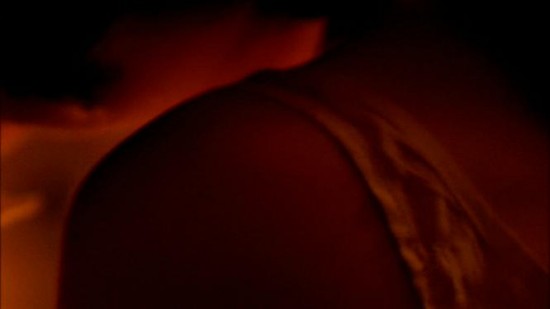
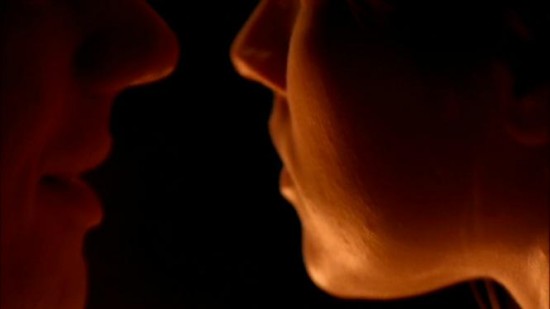

 The music composed by Phipps enhances this mix of the sensual and the sinister by playing off a quiet but piercing violin score against diegetic sounds in the form of heavy breathing, fire crackling, and brief dialogue.
The music composed by Phipps enhances this mix of the sensual and the sinister by playing off a quiet but piercing violin score against diegetic sounds in the form of heavy breathing, fire crackling, and brief dialogue.
Willoughby seducing Eliza.
(Click here to listen.)
Throughout the morning-after scene that follows, and in which the two lovers are now physically and emotionally apart, Bobbit places a blue filter over the camera lens. As a result, both the young man, who rides away and out of the frame, and the girl, who is shot in close-up and carefully positioned, like a prisoner, behind closely spaced window lattices, are bathed in a cold and eerie light. The overall effect is to expose the illusory nature of the film’s romantic opening scene.
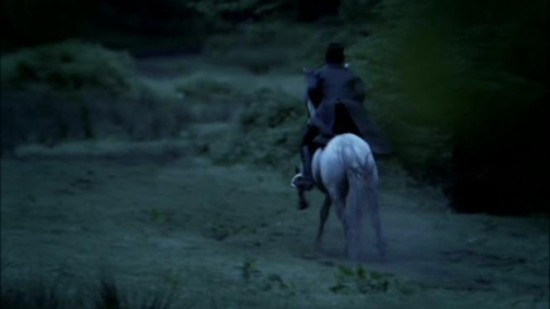
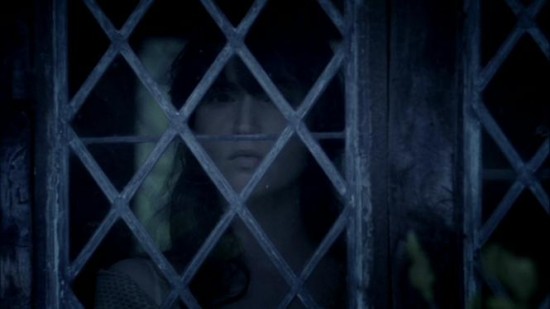
As we can see, then, lighting, editing, filters, camera movement and changes in distance, and music combine in the seduction episode to capture the emptiness of all that the young man has promised, the disillusionment of the girl, and the fundamental heartlessness of the whole business.
Shots of Willoughby riding away from the site of his seduction are followed immediately after the titles by even darker shots of a carriage also moving away from the camera. We quickly realize that it is carrying John Dashwood on his journey to Norland, where he will also make promises that are soon to be broken. Director, cinematographer, and editor thus employ visual means to reinforce the linkage so powerfully expressed in Davies’s script between the two acts of betrayal.
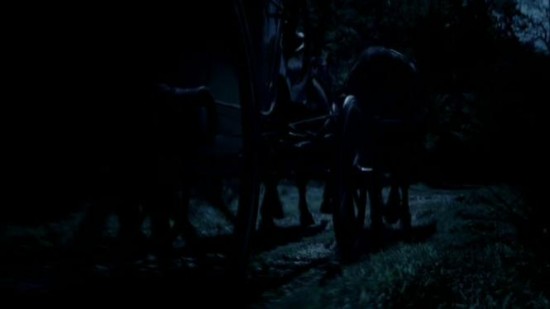
Two scenes: Inheritance and Betrayal
In scripting the conversation during which Fanny Dashwood persuades her husband to renege on his initially generous impulses towards his stepmother and her children, Davies relied heavily on Jane Austen’s comically sardonic dialogue, although he did divide it up amongst several discrete scenes. Alexander, Bobbit, and Sharman were thus given the opportunity to add a powerful visual element to the conversation by creating a montage of images that capture key moments in the John Dashwoods’ passage from their home in London to Norland. These images add a temporal and spatial dimension to a potentially static conversation and serve as a metaphor for the distance travelled by John Dashwood as he is led by his wife on a journey from original good intentions to a final selfish denial of familial obligations.
Those responsible for properties also took guidance from Davies’s script and provided ample evidence that John and Fanny are already extremely wealthy. Davies, who enjoys injecting modern references into his scripts, refers to “servants bringing down lots of Louis Vuitton luggage” and to “their travelling finery” as indications that “the Dashwoods are not short of a few bob.”

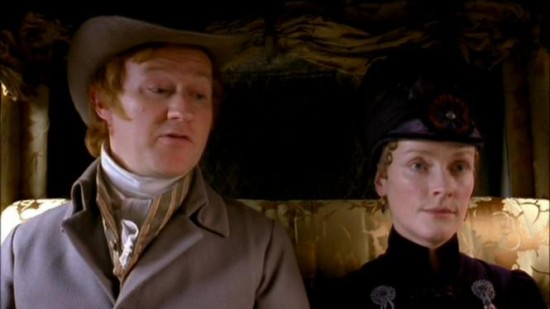
Andrew Davies’s adaptation of Austen’s dialogue is sufficient to create a Fanny Dashwood very close to Jane Austen’s original. However, the work of the film’s set, hair, and costume designers not only adds a visual dimension to Fanny’s mean-spiritedness but also conveys a perverse eroticism hinted at by Davies’s comment in the script that “property really turns [Fanny] on.” Fanny’s voice saying “Norland, ours at last,” over an extreme wide shot of the house’s impressive façade—seen in an earlier screen capture—is followed by several medium close-up shots of Fanny that are made extremely sensual by warm candlelight playing on her bedroom’s orange, gold, and red draperies. The eroticism of the mise-en-scène is completed by a pillow, serving as a synecdoche for the marital bed, her loosely fitting night dress, the long copper hair streaming down her neck, and the placing of the candle so that her face glows with its light. Fanny’s coy instruction that John “blow out the candle, dear” carries with it more than a hint that he will be the beneficiary of her sexual arousal. I am indebted to Susan Allen Ford for the further suggestion that Fanny uses her sexual allure as one of her tools for getting what she wants. Thus, in the film’s opening scenes we see both Willoughby and Fanny Dashwood use sex for purposes of power and control rather than as an expression of love.
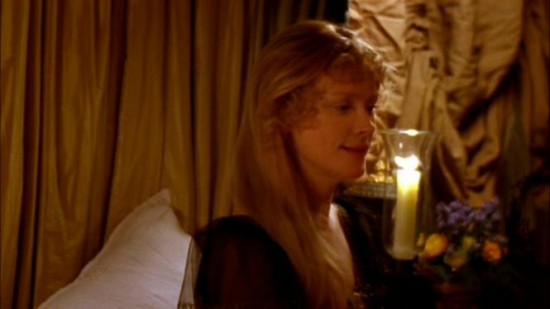
The warmth of this scene is enhanced by its contrast to the predominantly grey and black colors of the previous scene depicting the funeral procession at Norland. At the same time, though, the scene’s underlying irony is reinforced by the reminder that Fanny’s gain is the result of a terrible loss for the Dashwood women.

Later close and long shots of Fanny emphasize the underlying coldness and rigidity of a person whose eroticism has materialistic rather than emotional roots. The same hair that flows freely in the bedroom scene is from now on always screwed up into tight ringlets.

Similarly, Fanny’s loose fitting bedroom attire is replaced with a militaristic outfit. Such costumes were fashionable in a period of prolonged warfare, but authenticity is clearly not the only motive for such a choice on the part of the costume designer.
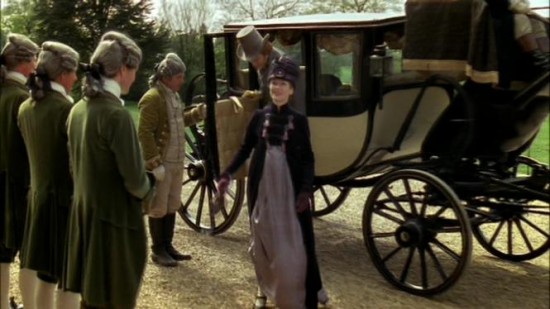
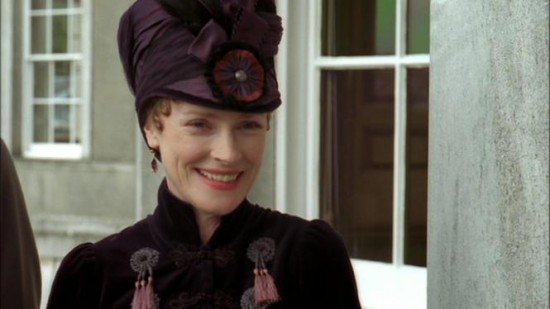 Fanny’s appalling but sometimes very funny hypocrisy is further highlighted by the scriptwriter, casting director, and costume designer’s creation of “Little Henry.” Henry appears in the novel but is not described or given anything to do or say. His only role is to provide Fanny with an opportunity to use the highly unlikely prospect of his impoverishment as one of the arguments with which she counters her husband’s generous impulses. Davies, however, wanted to make much more of the character, and in his script he asks that Henry be played by a plump and prosperous looking child, “a late eighteenth century version of Cartman from South Park . . . , a little prince,” who is usually to be seen “stuffing his face with the late-eighteenth century version of Cheesy Poofs.”
Fanny’s appalling but sometimes very funny hypocrisy is further highlighted by the scriptwriter, casting director, and costume designer’s creation of “Little Henry.” Henry appears in the novel but is not described or given anything to do or say. His only role is to provide Fanny with an opportunity to use the highly unlikely prospect of his impoverishment as one of the arguments with which she counters her husband’s generous impulses. Davies, however, wanted to make much more of the character, and in his script he asks that Henry be played by a plump and prosperous looking child, “a late eighteenth century version of Cartman from South Park . . . , a little prince,” who is usually to be seen “stuffing his face with the late-eighteenth century version of Cheesy Poofs.”
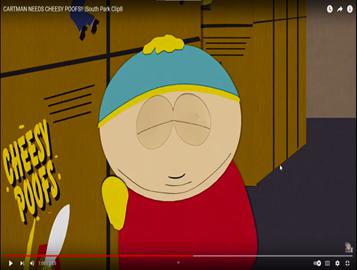 Davies’s instructions were brilliantly executed by Kate Rhodes James, the casting director, who chose for the part Morgan Overton, a chubby, round-faced little boy whose consistently impassive expression gives him the air of a somewhat sinister Buddha.
Davies’s instructions were brilliantly executed by Kate Rhodes James, the casting director, who chose for the part Morgan Overton, a chubby, round-faced little boy whose consistently impassive expression gives him the air of a somewhat sinister Buddha.
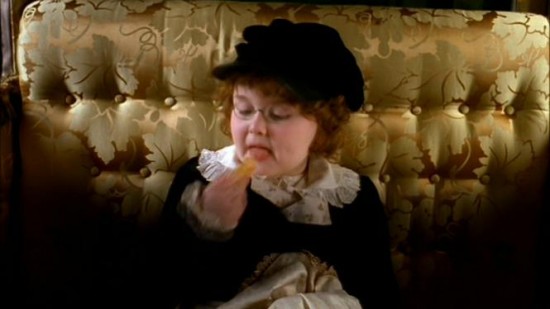 The possibility that this more than well-fed child could be in danger of imminent poverty is further undermined by the costume designer, Michelle Clapton’s decision to dress him in an expensive looking velvet cap, round gold glasses, an elaborate lace collar, and a very formal bum freezer jacket. Henry’s greed for food clearly mirrors his parents’ for money, a connection that is reinforced by hair designer, Karen Harley-Thomas's choice of ginger wigs for both Henry and his father.
The possibility that this more than well-fed child could be in danger of imminent poverty is further undermined by the costume designer, Michelle Clapton’s decision to dress him in an expensive looking velvet cap, round gold glasses, an elaborate lace collar, and a very formal bum freezer jacket. Henry’s greed for food clearly mirrors his parents’ for money, a connection that is reinforced by hair designer, Karen Harley-Thomas's choice of ginger wigs for both Henry and his father.
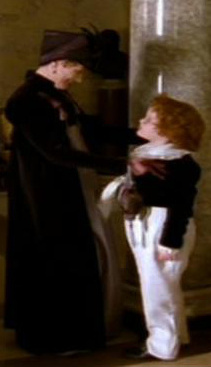 |
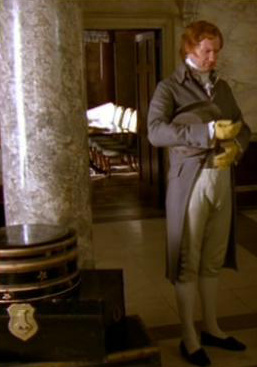 |
![]()
As the preceding discussion has tried to demonstrate, there is, in general, a remarkable degree of coherence among the many creative inputs that went into the making of the 2007 Sense & Sensibility. This is true both of sections of the film that stay close to the original novel and of those that deviate from their source. There is, however, one important way in which the collaborative process threatens to break down. This occurs when John Alexander’s romantic impulses threaten to undercut the sometimes satirical thrust of Davies’s presentation of Marianne Dashwood and to raise questions concerning how the audience is intended to respond to Marianne’s final rejection of the cult of sensibility in favor of her sister’s more balanced approach to life. A similar ambiguity bedevils the earlier Thompson/Lee adaptation of Sense and Sensibility, raising the possibility that somewhere in the multiple authorship of an Austen adaptation, there will inevitably be a degree of blindness to the complexities of her satire or an accommodation to the romantic urges of the modern-day cinema audience. That is a topic, though, for another paper.
NOTES
The clips used in this essay satisfy the criteria for fair use established in Section 107 of the Copyright Law of the United States of America and Related Laws Contained in Title 17 of the United States Code.
1However, as Susan Allen Ford points out, the Lee/Thompson film exercised a significant influence on the 2007 adaptation. Ford identifies such similarities as the enhancement of the roles of Margaret, Edward, and Brandon; the presentation of a gift to Elinor by Edward as they part at Norland—a handkerchief in the first instance and a book in the second; attempts to make Marianne’s eventual love for Brandon more plausible by showing an early attraction; and the introduction of dramatic scenes in which Brandon rescues Marianne from a storm at Cleveland.
In addition, we might note the following occasions when the 2007 film seems to have been inspired by the 1995 film rather than Austen’s novel: both films distribute the conversation in which Fanny Dashwood convinces her husband that there is no need to help his impoverished relatives among a sequence of shots covering the preparations for and the carriage ride to Norland; both demonstrate Marianne’s romantic preferences through a comparison of the hothouse flowers that Brandon brings to the Dashwoods’ cottage with the much more acceptable gift of wild flowers (1995)/wild strawberries (2007) that Willoughby brings—Marianne's later change of perspective is indicated by the bowl of cultivated strawberries and peaches that is frequently in shot during her visit to Delaford; both include a dramatized version of Brandon’s sudden departure from Barton involving, in each case, a messenger on horseback; in both Brandon accompanies the carriage that carries the Dashwood women from London to Cleveland; both add a hunting scene during which Sir John Middleton talks to Brandon about his relationship with Marianne—Jane Austen, of course, never includes scenes featuring only men; in both films, the evening party at which Willoughby snubs Marianne is transformed into a ball; and both films create similar shot sequences that trace the Dashwood women’s hasty preparations for Edward’s unexpected arrival at Barton Cottage ending with comically formal tableaux of ladies at leisure.
In the end, though, the films are quite distinct from each other, not just because of differences in the ages of their main characters but for stylistic reasons. Lee’s direction is slower and more leisurely and aims for a lyrical style whereas Alexander uses rapid editing, changes of distance and angle to create a much more dynamic style.
2Davies has claimed the scene in which Edward chops wood as his own: “I even wrote him a log splitting scene. . . . [Dan Stevens] was soaked to the skin, so we might have another wet shirt scene” (Pivcevic and Davies). However, this incident is not in Davies’s script and Dan Stevens has suggested that Davies was mistaken to claim it as his own (DVD Commentary Track).
3See Mangiavellano for a development of the idea that Elinor and Edward are expressing emotions that they usually suppress.
4Examples include Henry James’s The Turn of the Screw, William Golding’s Lord of the Flies, John Wyndham’s The Midwich Cuckoos. Such characters are a recurring feature in horror movies such as The Shining, The Omen, The Exorcist.
5According to Anne Pivcevic, John Alexander made the key decisions about lighting and shots for the seduction scene.
